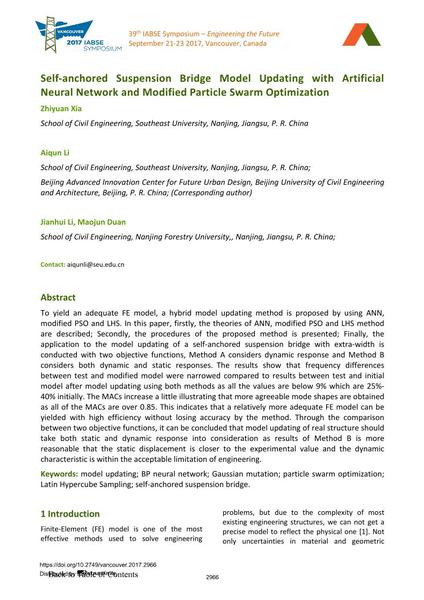Self-anchored Suspension Bridge Model Updating with Artificial Neural Network and Modified Particle Swarm Optimization

|
|
|||||||||||
Bibliografische Angaben
| Autor(en): |
Zhiyuan Xia
(School of Civil Engineering, Southeast University, Nanjing, Jiangsu, P. R. China)
Aiqun Li (School of Civil Engineering, Southeast University, Nanjing, Jiangsu, P. R. China; Beijing Advanced Innovation Center for Future Urban Design, Beijing University of Civil Engineering and Architecture, Beijing, P. R. China; (Corresponding author)) Jianhui Li (School of Civil Engineering, Southeast University, Nanjing, Jiangsu, P. R. China; Beijing Advanced Innovation Center for Future Urban Design, Beijing University of Civil Engineering and Architecture, Beijing, P. R. China; (Corresponding author)) Maojun Duan (School of Civil Engineering, Nanjing Forestry University,, Nanjing, Jiangsu, P. R. China;) |
||||
|---|---|---|---|---|---|
| Medium: | Tagungsbeitrag | ||||
| Sprache(n): | Englisch | ||||
| Tagung: | IABSE Symposium: Engineering the Future, Vancouver, Canada, 21-23 September 2017 | ||||
| Veröffentlicht in: | IABSE Symposium Vancouver 2017 | ||||
|
|||||
| Seite(n): | 2966-2973 | ||||
| Anzahl der Seiten (im PDF): | 8 | ||||
| Jahr: | 2017 | ||||
| DOI: | 10.2749/vancouver.2017.2966 | ||||
| Abstrakt: |
To yield an adequate FE model, a hybrid model updating method is proposed by using ANN, modified PSO and LHS. In this paper, firstly, the theories of ANN, modified PSO and LHS method are described; Secondly, the procedures of the proposed method is presented; Finally, the application to the model updating of a self-anchored suspension bridge with extra-width is conducted with two objective functions, Method A considers dynamic response and Method B considers both dynamic and static responses. The results show that frequency differences between test and modified model were narrowed compared to results between test and initial model after model updating using both methods as all the values are below 9% which are 25%- 40% initially. The MACs increase a little illustrating that more agreeable mode shapes are obtained as all of the MACs are over 0.85. This indicates that a relatively more adequate FE model can be yielded with high efficiency without losing accuracy by the method. Through the comparison between two objective functions, it can be concluded that model updating of real structure should take both static and dynamic response into consideration as results of Method B is more reasonable that the static displacement is closer to the experimental value and the dynamic characteristic is within the acceptable limitation of engineering. |
||||

